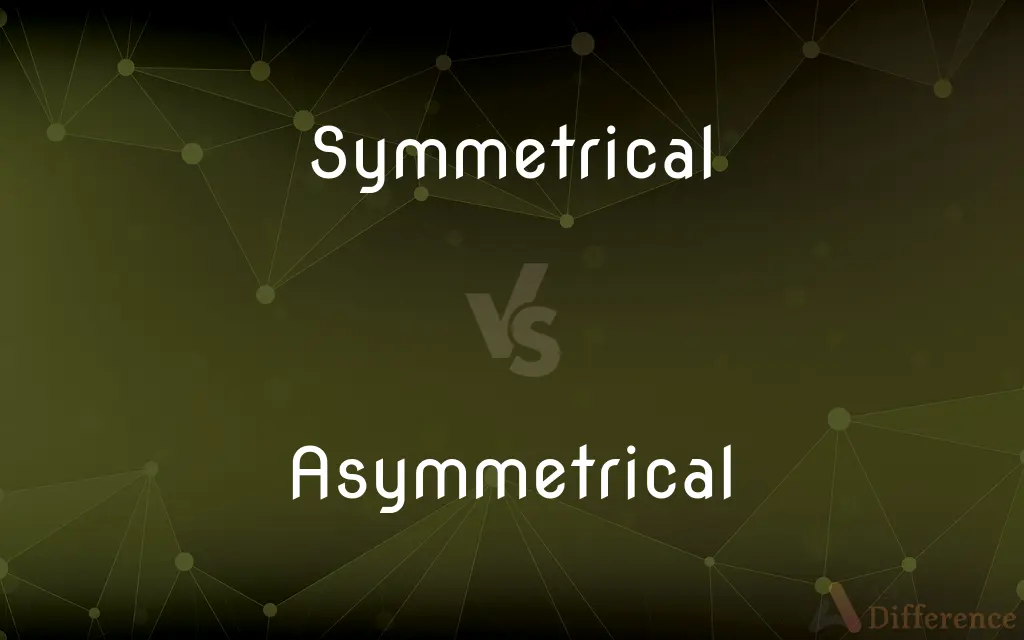Symmetrical vs. Asymmetrical — What's the Difference?
By Tayyaba Rehman — Updated on August 28, 2023
Symmetrical means having balanced proportions or identical parts facing each other. Asymmetrical lacks such balance or mirrored arrangement.

Difference Between Symmetrical and Asymmetrical
Table of Contents
ADVERTISEMENT
Key Differences
Symmetrical refers to an arrangement where elements on either side of a center line are balanced and mirror each other. Objects that have a symmetrical shape can often be folded in half, and each side will match the other perfectly. Asymmetrical, on the other hand, denotes an absence of symmetry, where the two sides don't mirror each other.
When considering design, symmetrical designs tend to impart a sense of order and formality. Such designs are often perceived as harmonious and balanced. Asymmetrical designs introduce an element of unpredictability and dynamism. They can make a design feel more spontaneous and less structured.
In nature, many living organisms exhibit symmetrical forms, such as butterflies and humans, when divided vertically. This kind of symmetry is often associated with beauty and evolutionary advantages. Contrarily, asymmetrical forms in nature can be seen in the irregular shapes of trees or certain cloud formations, emphasizing natural unpredictability and uniqueness.
Symmetrical balance is often found in classical art and architecture, where one side of an artwork or building mirrors the other. This creates a feeling of stability and formality. Asymmetrical balance, however, is seen in more modern art and design, embracing an off-center composition that challenges traditional aesthetics and generates interest.
In mathematics and geometry, a figure is described as symmetrical if it can be divided into two identical parts. For instance, a perfect circle or square is symmetrical. Asymmetrical figures don't have this property, and no matter how you try to divide them, the resulting parts won't be identical.
ADVERTISEMENT
Comparison Chart
Definition
Balanced and identical on both sides
Not identical or balanced on both sides
Art & Design
Creates a sense of order
Creates a sense of unpredictability
Perception
Seen as harmonious
Seen as unique and dynamic
Examples in Nature
Human body, butterfly
Tree branches, cloud formations
Use in Composition
Centralized and balanced
Off-center and dynamic
Compare with Definitions
Symmetrical
Maintaining the same form or arrangement throughout.
The team maintained a symmetrical formation during their performance.
Asymmetrical
Uneven in distribution or arrangement.
The dress had an asymmetrical hem, shorter on one side.
Symmetrical
Exhibiting balance in terms of proportion and arrangement.
The building had a symmetrical facade with windows evenly spaced on both sides.
Asymmetrical
Not identical on both sides of a central line.
The artist’s modern sculpture was distinctly asymmetrical.
Symmetrical
Having two sides that are identical, especially when divided by a center line.
The butterfly's wings were perfectly symmetrical.
Asymmetrical
Lacking balance or proportion in arrangement.
The room had an asymmetrical design with more furniture on one side.
Symmetrical
Having correspondence in size, form, and arrangement of parts on opposite sides of a plane.
The child drew a symmetrical heart on the paper.
Asymmetrical
Without symmetry.
The coastline had an asymmetrical shape with numerous inlets.
Symmetrical
Of or exhibiting symmetry.
Asymmetrical
Uneven in distribution.
Symmetrical
Exhibiting symmetry; having harmonious or proportionate arrangement of parts; having corresponding parts or relations.
Asymmetrical
Having parts that fail to correspond to one another in shape, size, or arrangement.
The building had an asymmetrical roof, making it stand out in the neighborhood.
Symmetrical
Relating to or involving symmetry.
The geometric pattern was symmetrical in nature.
Asymmetrical
Having no balance or symmetry
An asymmetric design.
Symmetrical
Having an equal number of parts in the successive circles of floral organs; - said of flowers.
Asymmetrical
Existing or occurring between two incommensurate entities, especially to the detriment of one.
Symmetrical
Involving or exhibiting symmetry; proportional in parts; having its parts in due proportion as to dimensions; as, a symmetrical body or building.
Asymmetrical
Characterized by an imbalance in power between two opponents in an armed conflict, especially one in which a weaker force uses unconventional means, such as guerilla or terrorist tactics
Asymmetric warfare.
Symmetrical
Having the organs or parts of one side corresponding with those of the other; having the parts in two or more series of organs the same in number; exhibiting a symmetry. See Symmetry, 2.
Asymmetrical
Not symmetrical.
Symmetrical
Having a common measure; commensurable.
Asymmetrical
(Chemistry) Of or relating to a carbon atom having four different atoms or structural groups attached to it, resulting in an unbalanced spatial arrangement of atoms in a molecule, so that the molecule cannot be superimposed on its mirror image; chiral.
Symmetrical
Having similarity in size, shape, and relative position of corresponding parts
Asymmetrical
(of a question) Presenting a false dilemma, or a choice between two things which are not opposites.
Symmetrical
Exhibiting equivalence or correspondence among constituents of an entity or between different entities
Asymmetrical
Characterized by asymmetry in the spatial arrangement or placement of parts or components
Asymmetrical
Irregular in shape or outline;
Asymmetrical features
A dress with an crooked hemline
Common Curiosities
What does symmetrical mean in design?
Symmetrical means that elements in a design are balanced and mirror each other on either side of a central axis.
Are humans symmetrical?
While humans may appear symmetrical externally, there are many internal differences and slight external variations that make us asymmetrical to some extent.
What's an example of something symmetrical in nature?
A butterfly is a great example of symmetry in nature, with both wings being mirror images of each other.
How is asymmetry used in art?
Asymmetry in art can challenge traditional aesthetics and create tension or intrigue, drawing the viewer's attention.
Can a design be both symmetrical and asymmetrical?
Typically, a design is either symmetrical or asymmetrical, but some complex designs might have areas of symmetry and asymmetry.
Why might someone choose an asymmetrical design?
Asymmetrical designs can add dynamism, unpredictability, and interest, breaking away from traditional or expected patterns.
Is the letter "A" symmetrical?
The capital letter "A" is symmetrical vertically, but this might vary depending on the font or style.
Is symmetrical always better than asymmetrical?
No, the preference for symmetrical or asymmetrical depends on the context and the desired outcome or effect.
Can asymmetry be balanced?
Yes, while asymmetry means a lack of symmetry, it doesn't mean a lack of balance. Designers can achieve balance using asymmetrical elements.
What's the opposite of symmetrical?
The opposite of symmetrical is asymmetrical.
Share Your Discovery

Previous Comparison
Larvae vs. Larva
Next Comparison
Mallard vs. DuckAuthor Spotlight
Written by
Tayyaba RehmanTayyaba Rehman is a distinguished writer, currently serving as a primary contributor to askdifference.com. As a researcher in semantics and etymology, Tayyaba's passion for the complexity of languages and their distinctions has found a perfect home on the platform. Tayyaba delves into the intricacies of language, distinguishing between commonly confused words and phrases, thereby providing clarity for readers worldwide.













































